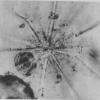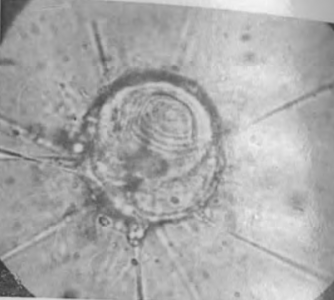Amoebophrya acanthometrae
Diagnosis
Diagnosis_Genus: Amoebophrya Koeppen 1984. Intracellular parasites. Smallest trophonts observed have 3 µm long, a gymnodiniales form, with a large hypocone and a small rudimentary epicone. The hypocone broadens at its base and forms a cup-shaped circumvallation, turning in spiral. The hypocone starts to cover the epicone (in other word, the epicone becomes progressively invaginated into the hypocone, forming a cavity, the mastigocoel, which is a characteristic of the genus Amoebophrya. This mastigocoel remains open by a small aperture at the apex of the trophont. Sporogenesis starts rapidly during this transformation. The inner surface of the mastigocoel is furnished with helically coiled ridges as a result of a continuous lengthening of the previous dinospore girdle during the trophic growth. Along these ridges countless flagella are inserted. Flagella of future dinospores (the free-living stage of the parasite) are produced inside the mastigocoel. At the end of the intracellular maturation, flagella started to beat, and what was the epicone at the origin, directed through the aperture of the mastigocoel, moved forward. This evagination make the flagella outside the structure, which is now called the vermiform. This action breacks out the host membrane, releasing the vermiform outside. This vermiform is closed forward (at the epicone side), but open in the back. When release, this part forms a large digestive vacuole that contains what remains from the host. This vermiform considerably strechs out with time. The spore chain forming the vermiform rapidly separates to produce spores (gymnodinial shape), generally of two different sizes (macrospores and microspores). These spores have a large epicone and a reduced hypocone (the reverse of what is observed during the first stage of the trophont).
Diagnosis_Species: Amoebophrya acanthometrae Koeppen 1894. This parasite starts to develop in the nucleus of the Acantharian. The trophont develops as in other Amoebophrya species, with the exception that no mitotic division of the nucleus occurs during this stage. The mastigoceol aperture is nowaday narrower, maintained by short fibrillar bundles resembling to the sea urchins mouth. Cytopharynx (as described for A. ceratii) is absent, the trophont feeds by osmotrophy (see Cachon and Cachon 1969). The vermiform release is similar to what is described in A. rosei, but all steps are slower, partly because of the voluminous nucleus. The digestive vacuole is rather large, and contains rest of the acantharian and its phototrophic symbionts. Active mitotic divisions start few hours after the release of the vermiform. Nuclei then migrate to be regularly distributed inside the vermiform. Two type of spores (macro and microspores) are produced.
Etymology
Amoebophrya: looks like to an amibe (Koeppen 1894).
acanthometrae: infects Acantharian (Koeppen 1894).
Type species
The type species (lectotype) of the genus Amoebophrya is Amoebophrya acanthometrae Borgert 1897
Ecology
Substrate_spores: planktonic
Substrate_trophont: endozoic
Sociability: solitary
Sociability: colonial
Salinity: marine
pH: neutral
Feeding: Parasitism (by phagotrophy)
Life cycle
Phases_alternance: haplontic
Generation: <1 month
Reproduction_mode: asexual_binary
Symbiont: horizontal_active-penetration
Feeding behaviour
Mode of locomotion
Reference(s)
Observation site(s)
Observation site(s)
HOSTS
| Association with... | Region origin | Name of site | In reference... |
|---|---|---|---|
| Acanthometra claparedei | |||
| Acanthometra serrata |
(1894) Amoebophrya stycholonchae nov. gen. et sp. (corps spiral de Fol). Zoologischer Anzeiger 17:417-424. |
||
| Acanthostaurus purpurascens |
(1894) Amoebophrya stycholonchae nov. gen. et sp. (corps spiral de Fol). Zoologischer Anzeiger 17:417-424. |
SYMBIONTS
| Association with... | Region origin | Name of site | In reference... |
|---|---|---|---|
| Amoebophrya ceratii-species complex |
(1964) Contribution à l’étude des péridiniens parasites. Cytologie, cycles évolutifs. Ann. Sci. Nat. Zool. 6:1-158. |


























